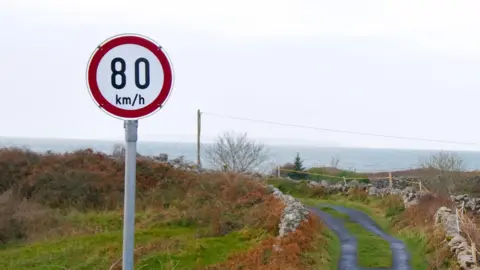Speed limits on some Irish rural roads reduced
 Getty Images
Getty ImagesSpeed limits on some roads in the Republic of Ireland will be reduced from 80km/h (50mph) to 60km/h (37mph) on Friday.
This change impacts small "rural local roads", with further reductions to other roads to be implemented later in 2025.
Plans include reducing limits on national secondary roads, such as dual carriageways, from 100km/h (62mph) to 80km/h (50mph) and on urban roads from 50km/h (31mph) to 30km/h (18mph).
The plans follow recommendations made in a review commissioned by the Irish government's Department of Transport in 2023.
The policy background says that an increase in fatalities and serious injuries recently has sparked the need for lower speed limits.
The government said statistics show road deaths before 2021 had been falling since 2006, when there were 365 fatalities on the roads
However, following this there were two successive years of increase where fatalities rose from 132 in 2021 to 180 in 2023.
An Garda Síochána (Irish police force) said it would "work with local authorities to ensure these changes are enforced".
"Public-awareness campaigns will be launched to educate drivers about the new limits and the importance of adhering to them," it said.
The police service added that measures to "achieve compliance" include "vehicle-mounted and handheld speed-detection equipment, and safety-camera vans".
Many unaware of changes
Heading south from Newry in County Down, Omeath is the first village south of the border between Northern Ireland and the Republic of Ireland, on the shores of Carlingford Lough.
Many visitors and locals were unaware of the speed limit changes.
On some of the local routes in and out of the village, new signs have been erected with the new 60km/h (37mph) limit.

William Lane, from Dromore in County Down, is a regular visitor to the Cooley Peninsula but says he didn't know about the changes.
"I can understand why," he said as he enjoyed a coffee outside Café Rosa.
"They did employ a 20mph speed limit in Wales. Time will tell."
Aisling O'Hanlon, who owns a hairdressing salon in the village, said many locals were also unaware.
"I didn't know this was happening," she said.
"I don't think people really drive too fast. I think we all stick to the speed limit but that could be a problem now if nobody knows – that's going to be the problem."

Customer Briege Rice said: "They are small roads. They are a bit windy so you couldn't drive fast on them.
"I don't think it will make much of a difference because I think people are genuinely careful."
But across the street in the café at the Grand Central Hotel customers give a different view.
Kathleen Elmore said: "I don't think you could reduce speed limits quickly enough.
"We have a school and a church and there are lights but a lot of people don't honour them.
"There's always someone quicker than you who wants to get here, there, wherever – slow down."
Briege and James Dunne agree.
"I think it's a good idea," said Briege.
"There are people going too fast, everywhere on all the roads we are on. Some will listen but a lot won't."
Similar changes in Wales
The Welsh government introduced similar measures in 2023, reducing the default urban speed limit to 20mph.
The latest casualty data for the first year of the new speed limit in Wales showed there were 100 fewer people killed or seriously injured on 20 and 30mph roads, a fall of 28%.
That data has been welcomed by Welsh ministers, but the Welsh conservatives say the policy remains confusing and frustrating for many motorists.
The scheme has proved to be one of the Welsh government's most controversial initiatives since devolution began, and almost half a million people signed a petition calling for it to be scrapped.
